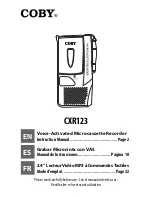
74
Glossary
MD4—Owner’s Manual
Ping-Pong
—A recording technique used to transfer (i.e., mix and rerecord) one or more
tracks to other tracks to free up those tracks for further recording. MD4 allows you to record
on all four tracks and then ping-pong (i.e., four-track playback with ping-pong). A feature
unique to MD4.
Pre-Roll Time
—For Auto Punch In/Out, this is the time before the IN point at which playback
starts. See Setting the Pre-Roll & Post-Roll Times on page 28 for more information.
Post Fader
—A point in the signal path after a fader. The signals for the MD4 AUX controls
are sourced post-fader. So as well as turn up the AUX control, you must also raise the fader. This
has the advantage that the level of the processed signal from the external effects processor is con-
trolled in unison with the unprocessed signal that is controlled by the fader.
Post-Roll Time
—For Auto Punch In/Out, this is the time after the OUT point at which play-
back stops. See Setting the Pre-Roll & Post-Roll Times on page 28 for more information.
Program
—A compilation of songs for custom playback. See Program Playback on page 43 for
Punch In/Out
—A recording technique that allows you to rerecord specific sections of an exist-
ing track. MD4 provides both manual and automatic punch in/out operations.
Random Access
—The ability to access data instantly. The MD4 quick locate functions allow
you to locate any point instantly. Tape-based recorders do not have random access capabilities
because they have to wind a tape, which takes time.
SCMS (Serial Copy Management System)
—A protection system intended to prevent
illegal copying of music. SCMS allows one-time serial copying of copy-protected material. If the
source is not copy protected, it’s possible to make any number of digital-to-digital copies of the
material. If the source is copy protected, however, it’s possible to make a first-generation copy,
but further copies cannot be made from the first-generation copy. SCMS is only effective when
copying via digital connections. Recordings made via analog connections are not affected.
Signal
—Sounds travel through audio equipment as electrical signals.
Signal to Noise Ratio (S/N)
—In an audio system, the difference between the nominal sig-
nal level and the residual noise floor, usually expressed as a ratio in decibels. It’s used as a measure
of an audio system’s noise performance.
Tempo Map
—A map containing the tempo and meter information for a song.
TOC
—An acronym for Table Of Contents. An area of the MD DATA disc used to store infor-
mation about what is recorded on the disc, the disc title, song titles, and so on.
Tracking
—The process of recording sounds to tracks on a audio recorder. Also know as laying
down tracks and just plain simple recording. Tracking is the first stage of the multitrack recording
process.
Unity Gain
—A gain of one. That is, the signal is output from a circuit at the same level at which
it entered. Once passed the MIC/LINE amplifier, a unity gain system minimizes signal noise and
distortion. The unity gain position for MD4 faders is at the 7–8 mark.







































